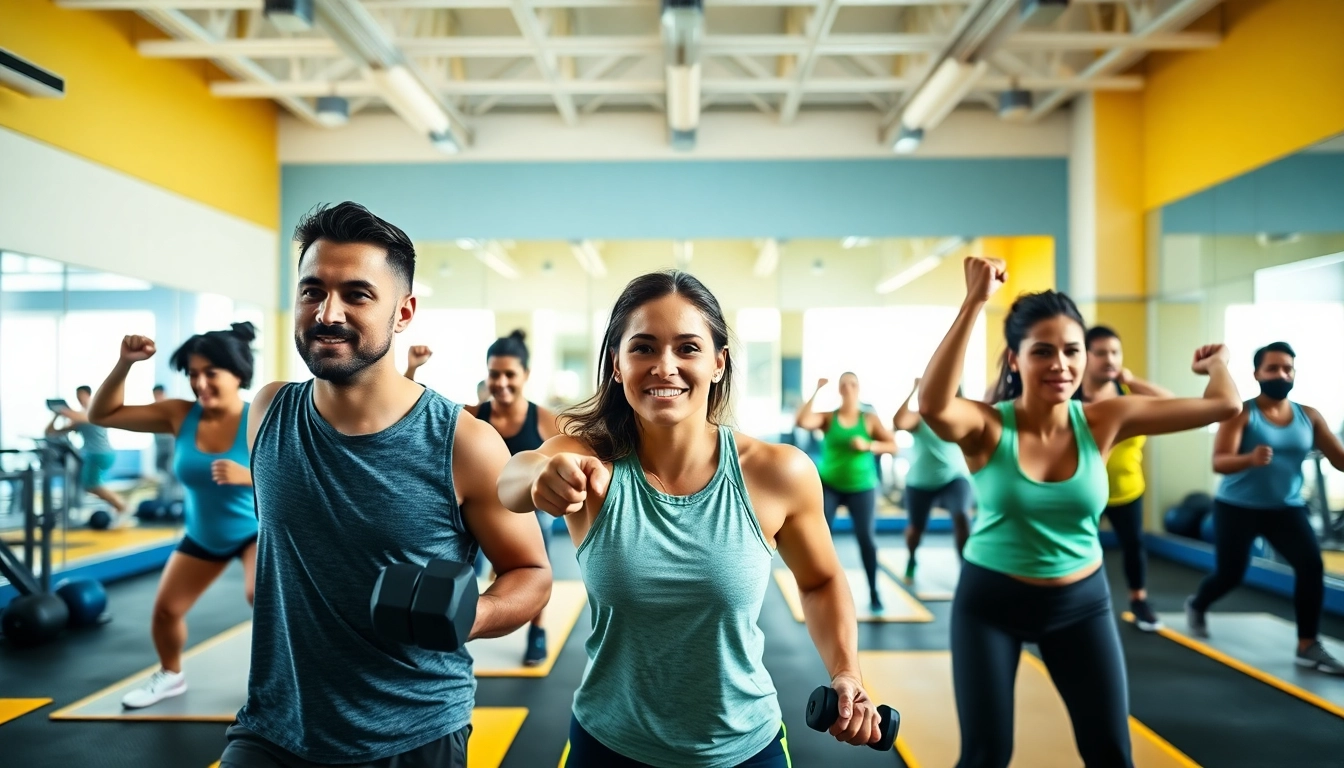
Maximize Your Fitness Journey with Engaging Gym Group Training Sessions
The Benefits of Gym Group Training
Gym group training has emerged as a favored option for fitness enthusiasts looking to enhance their workout routines. The concept emphasizes collective workouts led by qualified instructors within a supportive environment that fosters camaraderie. Participants not only gain physical fitness but also experiences and memories that can last a lifetime. Engaging in gym group training offers numerous benefits that go beyond mere exercise; let’s explore these advantages in detail.
Enhanced Motivation and Accountability
One of the most significant advantages of participating in gym group training is the increased motivation and accountability that comes from training alongside others. When individuals work out with a group, they often feel more compelled to push themselves harder than they would alone. The presence of others can elevate the experience, transforming a solitary effort into a supportive community endeavor.
Moreover, accountability is a powerful motivator. When participants commit to showing up for classes, they’re less likely to skip sessions due to the social obligations formed with fellow attendees and instructors. Studies have shown that workout partners can increase the likelihood of adherence to fitness programs, making group training not just more enjoyable but also more productive.
Social Interaction and Community Building
Gym group training serves as a fantastic platform for social interaction. As individuals gather to work towards common fitness goals, friendships often blossom. This sense of belonging can significantly impact mental well-being, contributing to motivation and overall happiness. In fact, many people find that the social aspects of working out in a group can make their fitness journey more enjoyable.
Additionally, group environments provide opportunities to meet new people from diverse backgrounds, leading to a dynamic and enriching experience. By participating in classes regularly, members often form strong connections, contributing to a sense of community within the gym. This can lead to increased loyalty and a higher retention rate for fitness facilities.
Variety and Fun in Workouts
Group training sessions typically involve structured programs that incorporate various exercises and equipment, ensuring that participants are never bored. The inclusion of high-energy music, themed classes, and diverse workout formats keeps the experience fresh and engaging. Whether it’s a high-intensity interval training (HIIT) class, dance aerobics, or strength training, the options are vast.
This variety is critical for long-term adherence to fitness programs. Repeated routines can lead to plateaus in progress and exercise fatigue, but with group training’s refreshing approach, participants remain excited about their workouts. Moreover, elements of gamification often emerge in group classes, further enhancing enjoyment and motivation.
What to Expect in a Gym Group Training Session
Entering a gym group training session for the first time can be intimidating; knowing what to expect can alleviate anxiety and set participants up for success. Generally, sessions follow a standardized structure, which can provide a comforting predictability while allowing for individualized improvement. Let’s dive into the common formats, typical equipment used, and the pivotal role of instructors.
Overview of Common Formats
Group training sessions come in multiple formats, each designed to meet varying fitness levels and goals. These include:
- High-Intensity Interval Training (HIIT): Short bursts of intense exercise followed by rest or lower-intensity exercise.
- Boot Camp: Combines cardio, strength training, and agility drills often inspired by military training.
- Yoga and Pilates: Emphasize flexibility, balance, and core strength, providing a holistic workout.
- Circuit Training: A series of exercises performed one after the other with minimal rest to keep heart rates up.
Understanding these formats allows participants to select and combine sessions that best suit their personal fitness visions. Always ask instructors about the focus of each class to ensure alignment with individual goals.
Typical Equipment Used
Depending on the type of group training session, various equipment can be expected. Commonly used items include:
- Dumbbells: Versatile for strength training; can be used for both upper and lower body exercises.
- Kettlebells: Great for dynamic movements combining strength and cardiovascular conditioning.
- Resistance Bands: Ideal for adding intensity to workouts while being gentle on joints.
- Medicine Balls: Useful for core workouts and partnering exercises.
- Steps and Aerobics Platforms: Often used in cardio-based classes to add an element of elevation and impact.
Familiarizing oneself with the equipment not only enhances workout effectiveness but also ensures proper usage, minimizing injury risk.
Instructor Roles and Their Impact
Instructors play a crucial role in group training sessions. They are responsible not only for leading workouts but also for building community and ensuring safety. A good instructor can make a significant difference in the overall experience by:
- Providing clear instructions: Ensuring that exercises are executed correctly, minimizing injury risks.
- Offering modifications: Tailoring workouts to accommodate different fitness levels and personal needs.
- Motivating participants: Encouraging individuals to push boundaries while staying positive and supportive.
- Creating engagement: Facilitating team-building activities and fostering relationships within the group.
A positive instructor-student dynamic can transform classes from mundane routines into exciting and fulfilling experiences. Regular feedback and communication can help participants achieve their goals more effectively.
How to Choose the Right Gym Group Training for You
With various gym group training options available, selecting the right program is crucial for maximizing effectiveness and enjoyment. Here are essential aspects to consider during the selection process.
Identifying Your Fitness Goals
Begin by clarifying your fitness goals; these goals will guide your choice of classes. Whether you aim to lose weight, build strength, boost athletic performance, or improve flexibility, there are programs tailored to specific outcomes. Take time to reflect on personal ambitions, and even consider consulting with a fitness professional to gain insights into suitable training programs.
Familiarize yourself with various class descriptions and the skills they promote. Engaging with programs that resonate with personal objectives can increase commitment and motivation significantly.
Evaluating Class Schedules and Locations
Once you have identified potential classes, evaluate their schedules and locations. Flexibility is key, as inconsistent attendance can hinder progress. Verify that class times fit into your existing commitments, including work and family obligations.
Location also matters; choose a gym that is conveniently accessible. A gym that is too far away might become an excuse to skip sessions. If possible, opt for trials at multiple gyms to evaluate the atmosphere, commute time, and overall convenience before making a long-term commitment.
Trial Classes and What to Look For
Participating in trial classes is one of the best ways to determine if a specific group training program is a good fit for you. Take advantage of free or low-cost trial class offers to gauge your feelings towards the workout, instructors, and fellow participants.
Pay attention to several elements during trial classes:
- Instructor’s teaching style: Ensure that their approach aligns with your preferred learning style.
- Class size: Decide whether you thrive in larger classes or prefer a more intimate environment for focused instruction.
- Atmosphere: The overall vibe should feel encouraging and motivating, promoting positive energy among participants.
Following trial sessions, take time to evaluate your experience before making final decisions.
Best Practices for Participating in Gym Group Training
Once you’ve found your ideal group training program, adopting best practices will enhance your experience and outcomes. Here are key recommendations to ensure that participation is not only fulfilling but impactful.
Preparing Physically and Mentally
Preparation is vital before attending group training sessions. This includes both physical and mental readiness. Physically, ensure you’ve got appropriate footwear, comfortable clothing, and any personal items like water bottles or towels. Proper hydration and nutrition leading up to classes are critical in optimizing performance and recovery.
Mental preparation also plays an essential role. Approach each session with a positive mindset and readiness to engage fully. Set clear intentions for what you aim to achieve with each workout, and mentally visualize your success in accomplishing these goals.
Fostering a Supportive Environment
Group training is as much about relationships as it is about fitness. Encourage fellow participants, celebrate their successes, and build a sense of community. Expressing kindness and support can create a positive atmosphere that benefits everyone involved. Cultivate friendships beyond training, which can further increase accountability and motivation.
If you’re a more seasoned participant, consider mentoring newcomers to create a welcoming environment. Sharing your experiences can enhance bonds and make the group stronger.
Setting Personal Challenges and Goals
Set personal challenges to keep pushing your limits while participating in group training. These can include increasing weights, enhancing speed, or mastering specific moves. Find measurable metrics to track performance progress, ensuring challenges remain motivating but attainable.
Communicate personal goals with the instructor; they can provide support and offer suggestions for adjustments to help you overcome hurdles effectively.
Tracking Progress in Gym Group Training
Monitoring progress is essential for sustained success in group training programs. By setting clear benchmarks and utilizing technology, participants can keep track of improvements to ensure they remain on course with their fitness journeys.
Setting Smart Fitness Goals
Utilize the SMART (Specific, Measurable, Achievable, Relevant, Time-bound) framework when setting fitness goals. This approach ensures that goals are clear, realistic, and time-sensitive. For instance, instead of saying, “I want to get stronger,” one could specify, “I want to increase my squat weight by 10 pounds by the end of the month.” This clarity can help maintain focus and motivation through various training phases.
Utilizing Fitness Technology
Leverage fitness technology to enhance accountability and motivation. Fitness trackers and smartphone applications can track workouts, monitor heart rates, and measure progress over time. By logging workouts, participants can visualize improvements, leading to more informed decisions about training intensity and frequency.
Additionally, many gyms provide digital platforms where participants can connect, share progress, and celebrate milestones together, further enriching the community experience.
Celebrating Milestones with the Group
Recognizing and celebrating milestones can significantly impact group dynamics and personal motivation. Whether it’s completing a specific number of classes, achieving a personal best, or reaching a fitness benchmark, highlight these accomplishments during training sessions.
Group leaders can initiate celebrations, create awards, or even conduct feedback sessions where successes are recognized publicly. Acknowledging progress bolsters group morale and motivates everyone to continue striving for their individual goals.



